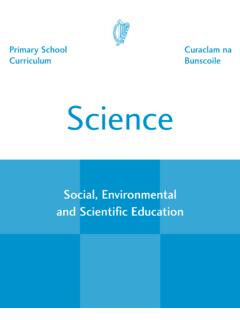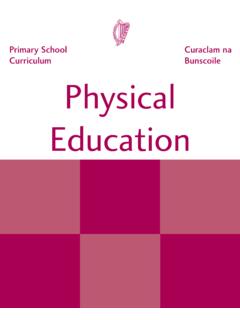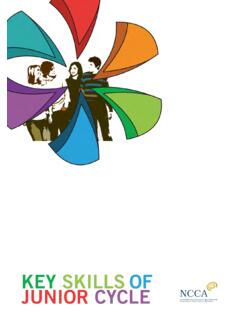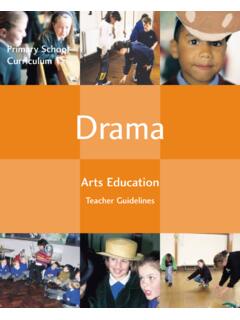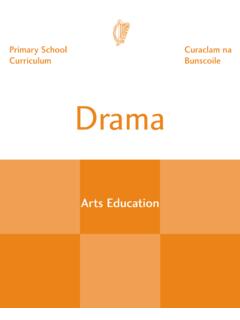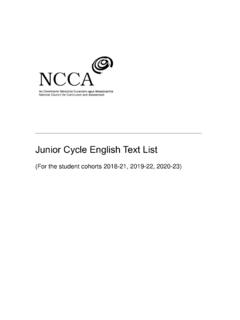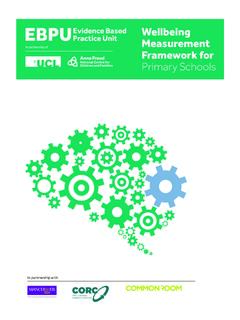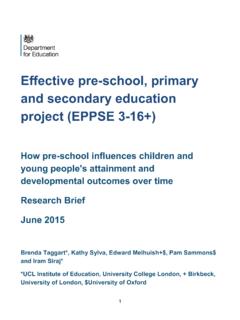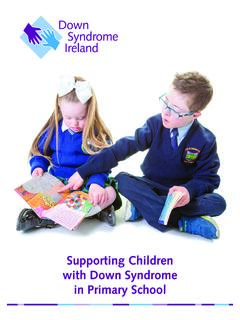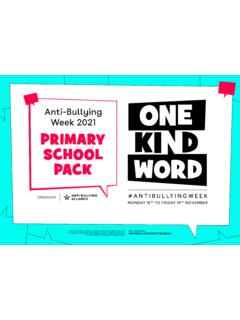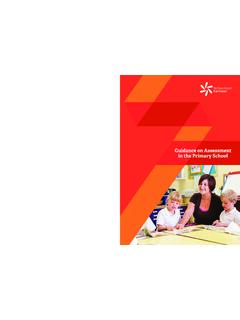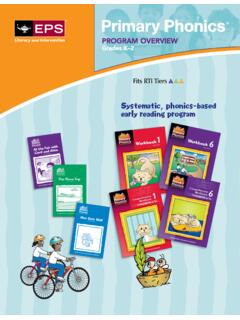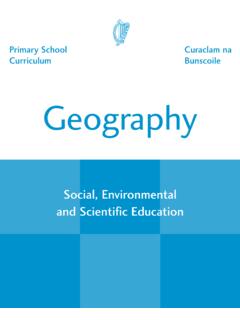Transcription of Primary School Curaclam na Curriculum Bunscoile
1 Social, Environmentaland Scientific EducationHistoryPrimary SchoolCurriculumCuraclam naBunscoileD U B L I NPUBLISHED BY THE STAT I O N E RY OFFICETo be purc h ased dire c t ly from theG OVERNMENT PUBLICATIONS SALE OFFICESUN ALLIANCE HOUSEM O L E S WO RTH ST R E E TDUBLIN 2or by mail order fro mG OVERNMENT PUBLICAT I O N SP O STAL TRADE SECTION4-5 HARC O U RT ROA DDUBLIN 2( Tel: 01 - 6476834-5; Fax: 01 - 4752760 )or through any booksellerD esign Consulta n cy :B ra d l ey McGurk Pa rt n e rs h i pD esigned by :The Identity Busines sTy p es e tt i n g :Spectrum Print ManagementP r i n ted by :Mozzon Giuntina - Florence andOfficine Grafiche De Agostini - Nova ra 1999 Government of Ire l a n dHistorySocial, Environmental andScientific EducationCurriculumC o n te n tsIntroductionSocial, environmental and scientific education2 The SESE curriculum2 Aims5 History.
2 A sense of time6 The history curriculum6 Aims 12 Broad objectives13 Infant classesOverview15 Planning16 Skills and concepts development18 Content 19 First and second classesOverview23 Planning24 Skills and concepts development26 Content 27 History CurriculumThird and fourth classesOverview34 Planning36 Skills and concepts development40 Content 42 Fifth and sixth classesOverview54 Planning56 Skills and concepts development60 Content 62 AssessmentAssessment in SESE74 Assessment in history76 AppendixMembership of the Curriculum Committee for SESE88 Membership of the Primary Co-ordinating Committee89 IntroductionSocial, env i ro n m e n tal and scientific education (SESE) prov i d es oppor-t u n i t i es for the child to ex p l o re, inves t i g a te and develop an unders ta n d i n gof the natural, human, social and cultural dimensions of local and widere nv i ro n m e n ts, to learn and practise a wide range of skills, and to acquireopen, critical and responsible att i t u d es.
3 SESE enables the child to live asan informed and caring member of local and wider commu n i t i es .SESE takes place within, and contributes to, many areas of thecurriculum. It thus contributes significantly to many aspects of the child sdevelopment. Within this Curriculum , SESE is presented under threesubject headings: history, geography and science. Each of these areas hasa distinctive role to play in enabling the child to explore and understandthe natural, human, social and cultural environments in which SESE curriculumUnderstanding the term environment An understanding of the term environment is fundamental to anappreciation of the nature of social, environmental and scientificeducation. The word environment is used in this Curriculum to denotethe surroundings or external conditions with which an individual (humanor other living organism) or community may be categorised in two broad groups.
4 Naturalenvironmentsare formed largely through the interaction of the earth sphysical features and processes, its flora and fauna. A tropical rainforest, apeatland or a rocky seashore may be examples of natural Ireland, human activity over thousands of years has shaped andchanged the landscape considerably. Environments which have beenmodified in this way are termed human environments. Areas which havebeen altered by the presence of people, farming activities, the extractionof resources, the provision of roads and other communication links andthe construction of buildings are all examples of human human env i ro n m e n ts, such as urban are as, are pre d o m i n a n t ly theconstructions of people and are termed built env i ro n m e n t s .Other hu m a ne nv i ro n m e n ts result from social and cultural activities and are entire lyhuman creations.
5 As people live and wo rk to g e t h e r, social patte r n s ,relationships, sys tems and institutions are evo lved, while hu m a nexperience, knowledge, va l u es and beliefs are ex p ressed, developed andSocial, environmental andscientific education2p e r p e t u a ted through a range of cultural activities. Pa tterns of hu m a nb e h av i o u r, the social institutions developed by people and the politicaland economic sys tems which they utilise are as p e c ts of social env i ro n m e n t s;a rtistic, religious, ethnic, scientific, technological and re c re a t i o n a la c t i v i t i es are as p e c ts of c u l t u ral env i ro n m e n t s .Exploration and investigationA key characteristic of learning within SESE is the involvement of thechild in the active exploration and investigation of all of theseenvironments.
6 Historical education enables children to investigate and examinecritically significant events in their own immediate past, the past of theirfamilies and local communities and the histories of people in Ireland andother parts of the world. History develops an understanding of theactions, beliefs and motivations of people in the past and is fundamentalto an informed appreciation of contemporary society and environments. In geographical education, children explore and learn about features inhuman and natural environments, especially those in the immediatelocality. They investigate the processes which create, sustain or changephysical features and the interactions of people with each other and theirenvironments in the locality and wider education enhances children s knowledge and understanding ofthemselves and the world in which they live.
7 It involves children in theactive construction of their own understanding. This understandingchanges in response to the children s broadening experiences. A scientificapproach to investigations fosters the development of important skills,concepts and knowledge through which children can observe, question,investigate, understand and think logically about living things and theirenvironments, materials, forces, everyday events and problems. Theknowledge and skills acquired may be applied in designing and makingactivities in which children perceive a need to create or modify elementsof their environments. 3 The SESE CurriculumValues, attitudes and responsibilitiesSESE is also concerned with the cultivation of important values andattitudes. It fosters an appreciation of the inter-relationships of all livingthings and their environments and encourages children to become activeagents in the conservation of environments for future their investigations, children develop informed, critical andscientific perspectives which acknowledge the importance of foundingjudgements upon a respect for facts, accuracy and reason.
8 SESE seeks togenerate an appreciation of cultural and historical inheritance andcultivates an atmosphere of equality and opportunity where gender,cultural diversity, minorities and special needs are respected and and discrimination are challenged while respect and mutualunderstanding are the Primary School years, the environments of the child,particularly those of a local nature, provide ideal contexts and acompelling impetus for the integration of learning. The subject headingshistory, geography and science are used to aid the presentation of thecurriculum, and an awareness of them is an important part of the child scultural and intellectual inheritance. Each subject offers a distinctiveperspective on the world and equips children with a particular range ofskills.
9 However, the use of these subject divisions must not negate theeffective implementation of an integrated Curriculum . The use of well-planned integrated approaches, both within SESE and between SESE andother curricular areas, will have an important part to play in the deliveryof the Primary Curriculum at all levels. Systematically planned integratedtopics can provide contexts in which knowledge and skills may bedeveloped in a range of areas. Many elements from the history, scienceand geography curricula may be explored concurrently, and much of thework involved will contribute to the development of oral language,literacy, numeracy, aesthetic awareness, creative expression andcommunication number of features have been incorpora ted in the Curriculum in ord e rto facilita te effective inte g ration.
10 SESE is best approached in a holisticmanner with younger children, as this res p e c ts the wholeness of their viewof the wo rld. Ac c o rd i n g ly, a considerable degree of ove rlap and similarityh as been embodied within the content sugges ted in the strands and4s t rand units of the three curricular sta te m e n ts for infants and first andsecond clas s es. Fu rther suggestions for inte g ra ted studies are included inthe accompanying guidelines for te a c h e rs .As children grow older they begin to recognise that there are differentways or modes of looking at the world and of organising humanknowledge, so teaching strategies may vary to include a holistic approach,some cross-curricular integration and a subject-centred focus. Possiblecross-curricular links and integrated studies are noted within the contentof the curricular statements for third to sixth classes.
